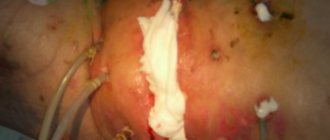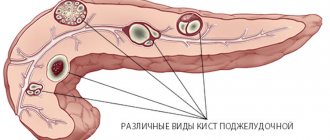Pancreatic cancer is a malignant tumor that is aggressive and prone to rapid growth into neighboring tissues. As the formation spreads, structural and functional disorders occur in the pancreas. Pancreatic cancer occupies a leading position among oncological diseases of the digestive organs. The number of diagnosed cases increases every year. Men suffer from the disease more often than women. Oncologists at the Yusupov Hospital diagnose pancreatic cancer using modern instrumental and laboratory research methods. They use equipment from leading Japanese, European and American manufacturers.
Doctors at the Oncology Clinic take an individual approach to choosing management tactics for each patient. Surgeons are fluent in the technique of radical and palliative surgical interventions. The use of the latest anticancer drugs can improve the quality and increase the life expectancy of patients. Medical staff provides professional care for patients.
Risks of occurrence
Scientists have not yet established the exact cause of pancreatic cancer. The growth of a malignant neoplasm can begin under the influence of the following provoking factors:
- Excessive smoking – causes ischemia (oxygen starvation) of organ tissue;
- Excess of easily digestible carbohydrates in the diet creates additional stress on the gland;
- Chronic pancreatitis - the development of atypical cells occurs against the background of an uncontrolled inflammatory process in the pancreas;
- Excess body weight - fat deposits affect internal organs, including the pancreas, and additional load increases the risk of developing tumors;
- Chronic intoxication – long-term toxic effects negatively affect the structure and functions of the pancreas;
- Oral diseases - caries, periodontitis, periodontal disease, which significantly increase the risk of the formation of tumor foci in the pancreas.
The highest incidence of pancreatic cancer is typical for economically developed countries, which are characterized by urbanization and high socio-economic indicators. Malignant neoplasms develop with a burdened heredity.
Tumor cells from other organs affected by the tumor process metastasize to the pancreas. More than 75% of patients with pancreatic cancer have reached 70 years of age. However, the pathology also affects younger people.
Expert opinion
Author:
Alexey Andreevich Moiseev
Oncologist, chemotherapist
Pancreatic cancer is a malignant tumor that develops in the glandular tissue or ducts of the organ. The tumor very quickly destroys tissue and grows into neighboring organs, so it is important to know the main symptoms of the disease in order to consult a doctor in a timely manner.
According to doctors, the main cause of the tumor is a genetic failure at the cellular level. As a result, the affected cells cannot perform basic functions, but multiply intensively, which leads to the formation of a tumor. Medicine is unable to find the root cause of oncology and answer the question of what gives impetus to the degeneration of healthy cells into cancerous ones. Research has been conducted for many years, but no clear cause of the pathology has been found.
Provoking factors are considered to be smoking, excessive alcohol consumption, diabetes mellitus, surgical interventions on the gastrointestinal tract, and poor environmental conditions.
Not a single doctor will answer you how long a patient will live or whether a patient will live at one or another stage of pancreatic cancer. It all depends on the severity of the pathology, the extent of the damage, and the state of the patient’s body. Doctors at the Yusupov Hospital practice an integrated approach to diagnosing and treating pancreatic cancer in a hospital setting.
Make an appointment
Pathogenesis
It is known that chronic pancreatitis increases the risk of pancreatic cancer by 9-15 times. The main role in the development of pancreatitis and cancer belongs to the stellate cells of the gland, which form fibrosis and at the same time stimulate tumorigenesis. Stellate cells, producing extracellular matrix , activate the destruction of gland cells and reduce insulin production by β-cells. At the same time, they increase the oncogenetic properties of stem cells, stimulating the occurrence of pancreatic cancer. And the constant activation of stellate cells disrupts the homeostasis of the tissues surrounding the tumor, which creates the ground for the invasion of cancer cells into neighboring organs and tissues.
Another factor in oncogenesis is obesity . Obesity undoubtedly affects the pancreas. Visceral fat is an active endocrine organ that produces adipocytokines . In insulin resistance, steatosis and inflammatory cytokines cause organ dysfunction. Elevated levels of free fatty acids cause inflammation, ischemia , organ fibrosis , and ultimately cancer .
The following sequence of changes in the pancreas has been proven - non-alcoholic steatosis , then chronic pancreatitis and cancer . Patients quickly develop cachexia , which is associated with dysregulation of the hormones ghrelin and leptin under the influence of the same cytokines. If we take into account gene mutations, it can take 10 years from the appearance of the first signs of mutations to the formation of a non-invasive tumor; then it takes 5 years for the transformation of a non-invasive tumor into an invasive one and the development of a metastatic form. And after this, the oncological process quickly progresses, leading to an unfavorable outcome within 1.5-2 years.
Symptoms
The insidiousness of pancreatic cancer lies in the fact that the initial stages of the disease are practically asymptomatic. There is no severe pain or obvious manifestations of any abnormalities in health or discomfort. You should be wary and immediately visit a doctor if the following symptoms appear:
- Pain in the abdominal area, radiating to the back, increasing with changes in body position;
- Yellowness of the skin;
- A sharp decrease in body weight;
- Loss of appetite;
- Nausea and vomiting, dizziness, loose stools, weakness for no apparent reason.
With malignant tumors, the pain heads are usually localized in the epigastric region. If the tumor is located in the tail of the organ, patients complain of pain in the left upper quadrant of the abdomen. Gradually the pain becomes more severe and constant, intensifying at night. It can be localized in the back (when it grows into retroperitoneal structures).
The nature of the pain changes when changing position. The patient feels relief when bending the body forward. Exacerbation may occur during attacks of acute pancreatitis. Pain in the left half of the abdomen, constipation or signs of intestinal obstruction are caused by metastasis of cancer of the body or tail of the pancreas to the colon.
Acinar carcinoma is accompanied by a syndrome of focal inflammation and subcutaneous lipoid necrosis. It is characterized by joint pain and increased levels of eosinophils in the blood, high levels of lipase in the blood serum. Similar symptoms are characteristic of recurrent pancreatitis. A non-local manifestation of pancreatic adenocarcinoma is superficial thrombophlebitis of a migratory nature. When the portal vein is blocked, esophageal varices develop. It leads to stomach bleeding.
Over time, jaundice becomes one of the main symptoms of pancreatic cancer. It is detected in 90% of patients with tumor lesions of the head of the organ. Jaundice is progressive. Tumor remission may result in less jaundice. In case of cancer of the tail and body of the pancreas, jaundice is rarely recorded. With the development of cholangitis, body temperature rises.
Upon palpation, a volumetric formation is determined in the projection area of the pancreas. When the tumor is localized in the head of the organ, an enlarged, painless gallbladder is palpable in the right hypochondrium. Infection with abdominal metastases leads to the development of ascites (accumulation of free fluid in the abdomen).
Patients in most cases seek medical help when their condition sharply worsens. As a rule, at this stage the cancerous tumor is already significant in size.
Diagnostics
Detection of a pancreatic tumor at the first stage is extremely rare. This is due to the absence of characteristic symptoms. Most often, cancer in the early stages is diagnosed during examination for another disease. At the Yusupov Hospital, research is carried out using modern equipment. It allows you to accurately and quickly determine the type and stage of tumor development. This is important for clarifying further treatment tactics.
Comprehensive diagnosis of pancreatic cancer includes:
- General and biochemical blood test. It is prescribed to identify the inflammatory process in the body. Pay attention to such indicators as ESR, leukocyte formula, ALT, AST, bilirubin, lipase, amylase and alkaline phosphatase;
- Coagulogram. Determined to assess the degree of blood clotting disorder;
- Determination of the level of tumor markers in the blood. CA-242 and CA-19-9 are considered specific tumor antigens for pancreatic cancer. An increase in their concentration indicates a high risk of tumor formation;
- Ultrasound examination (ultrasound) of the abdominal organs. Allows you to evaluate the structure of the pancreas, its size, as well as the location of the pathological focus;
- Computed tomography (CT) and magnetic resonance imaging (MRI). Layer-by-layer examination of the pancreas makes it possible to assess the location, size and degree of tumor invasion into adjacent tissues;
- Positron electron computed tomography (PET-CT). A contrast agent is used for the study. After the labeled isotope accumulates in the pancreas, the organ is examined for the presence of tumor formation;
- Endoscopic retrograde cholangiopancreatography. The head of the pancreas is examined using an endoscope. A contrast agent is injected through it, which stains the organ. A series of x-rays allows you to determine the location and size of the tumor;
- Laparoscopy is a high-tech and informative research method. During the procedure, it is possible to perform a biopsy for histological analysis of the tissue samples obtained from the pathological focus;
- Biopsies. Pancreatic cancer must be confirmed by histological examination. A biopsy can determine the type and stage of cancer. This is necessary to determine treatment tactics.
Diagnosis of pancreatic cancer in the early stages of the disease (before the lumen of the bile ducts closes and penetrates the duodenum) is difficult. Therefore, doctors at the Yusupov Hospital are especially attentive to patients who complain of prolonged pain that occurs without any reason in the left upper quadrant of the abdomen.
Evaluation with barium contrast X-ray is only useful if the tumor is large. An x-ray may show displacement of the stomach cavity and the posterior wall of the abdominal cavity. The tumor can affect the mucous membrane of the duodenum and stomach. When barium suspension is used, the structures have an irregular shape.
The use of ultrasound and computed tomography makes it possible to detect small tumors, including neoplasms of the body and tail of the pancreas. If the results of the study are negative, endoscopic ultrasonography is performed. Using computed tomography, tumor lesions of the pancreas and its penetration into the surrounding area, cancer metastasis to the liver and neighboring lymph nodes are determined. A puncture biopsy allows for histological examination and confirmation of the diagnosis.
Patients with obstructive jaundice undergo transhepatic cholangiography and endoscopic retrograde cholangiopancreatography. Transhepatic penetration reveals the proximal site of obstruction and helps distinguish pancreatic malignancy from cancer of the gallbladder, bile duct, or papilla of Vater. Using endoscopic retrograde cholangiopancreatography, narrowing of the common pancreatic duct and compression of the common bile duct by a neoplasm can be detected.
Endoscopic ultrasound is useful in cases where resection is contemplated. Before surgery, surgeons prescribe angiography to exclude involvement of draining veins in the tumor process. In approximately 60% of cases, cancer occurs in the head of the pancreas. Tumors are usually poorly demarcated.
Closure of the lumen of the pancreatic duct with an upstream dilation, as well as signs of chronic pancreatitis, create a “double-barreled shotgun” symptom when both ducts (pancreatic and common bile ducts) are dilated. These changes are detected by imaging. By the time doctors detect pancreatic cancer, the tumor has usually spread to nearby structures. In most cases, jaundice develops not just as a result of compression of the bile ducts, but as a result of tumor growth.
The diagnosis is confirmed in 75% of cases either cytologically (using fine-needle aspiration biopsy) or histologically (using internal biopsy under ultrasound guidance or computed tomography).
Ductal adenocarcinoma is detected in 80% of patients suffering from pancreatic cancer. They vary in the degree of differentiation, the presence of mucin, and the presence or absence of giant cells or squamous elements. Less commonly, malignant neoplasms have predominantly acinar characteristics or a main mucous (colloid) component. Oncologists at the Yusupov Hospital establish the final diagnosis and stage of the tumor process based on an analysis of the results of the studies.
Causes
The exact reasons have not been identified, but there is evidence of the role of certain factors:
- Diseases of the pancreas. First of all, chronic pancreatitis . In patients with alcoholic pancreatitis, the risk of malignant diseases of the organ increases 15 times, and with simple pancreatitis - 5 times. With hereditary pancreatitis, the risk of cancer is 40% higher.
- Pancreatic cysts, which in 20% of cases develop into cancer. A high risk of malignancy is indicated by a family history of cancer of this organ.
- Genetic mutations. More than 63 mutations are known to lead to this disease. 50-95% of patients with adenocarcinomas have mutations in the KRAS2, CDKN2 gene; TP53, Smad4. In patients with chronic pancreatitis - in the TP16 gene.
- Obesity , which is always associated with pancreatitis , diabetes and an increased risk of prostate cancer. Obesity during adolescence increases the risk of cancer in the future.
- Type of food. A diet high in protein and fat, lack of vitamins A and C, carcinogens in food (nitrites and nitrates). An increased content of nitrates in products leads to the formation of nitrosamines , and they are carcinogens. Moreover, dietary habits and the carcinogenic effects of foods appear after several decades. Thus, nutritional characteristics in childhood and young adulthood also matter.
- Increased levels of cytokines (in particular IL-6 cytokine), which play a role not only in the development of inflammation, but also in carcinogenesis.
- Smoking is a proven risk factor for cancer of this organ.
- Exposure to ionizing radiation and carcinogenic fumes (for example, in the aluminum industry, dry cleaners, oil refineries, gas stations, dyeing industries). These unfavorable environmental factors cause DNA changes and failure of cell division.
- Gastrectomy (removal of the stomach) or gastric resection. These operations for ulcers and benign tumors of the stomach increase the risk of pancreatic cancer several times. This is explained by the fact that the stomach is involved in the degradation of carcinogenic substances entering the body with food. The second reason is the synthesis of cholecystokinin and gastrin in the mucosa of the small intestine and pylorus (due to the absence of the stomach or part of it), and this stimulates hypersecretion of pancreatic juice and disrupts the normal functioning of this organ.
Classification
The classification of pancreatic cancer depends on the histological structure of the tumor and the location of the tumor. According to histological structure, malignant neoplasms of the pancreas are divided into:
- Squamous;
- Adenocarcinoma;
- Cystadenocarcinoma;
- Glandular-squamous;
- Unspecified cancer;
- Ductal adenocarcinoma.
The most common form of pancreatic cancer is adenocarcinoma. The tumor is formed from the epithelial cells of the ducts. It is accompanied by an intense fibrotic reaction. Cystadenocarcinoma has a generally favorable prognosis. Acinar cancer is observed in 5% of patients. Pancreatic sarcoma is a rare disease that is usually diagnosed in childhood.
In accordance with the location, cancer of the head, body, and tail of the organ is distinguished. In 65% of cases, the tumor is localized in the head of the pancreas, in 30% in the body and tail, and in 5% only in the tail. Malignant neoplasms of the head of the pancreas penetrate the duodenum. They obstruct the passage of the bile ducts, spread into the retroperitoneal space and peritoneal cavity, and form cysts. Tumors of the body and tail of the pancreas can penetrate the splenic vein, portal vein of the liver, and metastasize to the spleen and colon. Metastases of pancreatic cancer are often found in the liver, lungs and peritoneum.
The exocrine part of the pancreas has a well-developed network of lymphatic ducts that are located along the blood vessels. Tumors localized simultaneously in the tail and body of the pancreas spread through the lymphatic ducts.
Make an appointment
Types of PCa
The pancreas is an organ that performs two main functions: digestive (produces pancreatic juice rich in enzymes) and endocrine (produces insulin, glucagon and other hormones).
Cancer is classified according to the type of cells that have undergone degeneration. Exocrine
Ductal adenocarcinoma is registered in 90% of patients.
It affects the cells lining the pancreatic ducts. A more rare type of acinar cell carcinoma develops in cells that secrete digestive enzymes, called acini. Intraductal and cystic benign neoplasms can degenerate into malignant ones. Endocrine
Tumors of islet cells that produce hormones include conditionally benign (with the possibility of becoming malignant): insulinomas, glucagonomas and others. Occurs in 5–10% of cases.
Pancreatic cancer in men and women
Statistics show that men are more likely to suffer from pancreatic cancer. At risk are representatives of the stronger sex over 50 years of age, smokers, eat fatty and fried foods in large quantities, and are overweight. Therefore, when the first pathological symptoms appear, doctors recommend seeking medical help for a comprehensive examination.
Women are less likely than men to suffer from this disease. However, against the background of other somatic diseases, they do not pay attention to the early signs of pancreatic cancer. In this regard, there is a delay in seeking medical help and detection of the tumor at later stages.
Why is it important to seek help from a doctor at the first symptoms?
The Yusupov Hospital is well equipped, and the doctors have sufficient experience and qualifications to diagnose and treat even such complex diseases.
The earlier a tumor is detected, the more optimistic the treatment prognosis. Do not underestimate or conceal disturbing symptoms. Those who already have cancer status should be especially attentive to their health: the development of cancer of the head of the pancreas is sometimes caused by metastases of tumors of the skin, lungs, prostate gland, kidneys and other organs. Also at risk are often people over 60 years of age, patients with diabetes mellitus, chronic pancreatitis, cholelithiasis, and alcoholism.
Treatment
Treatment tactics for pancreatic cancer are determined by its stage of development, location and size of the tumor focus. Both conservative and surgical methods are used for therapy. Among them are:
- Surgical operations. Oncologists distinguish several types of surgical treatment performed for pancreatic cancer. They differ in the scope of intervention. In accordance with this, total, partial or segmental resection is distinguished;
- Chemotherapy. Most often used in conjunction with radiation therapy. The essence of treatment is the introduction of drugs into the body that stop the growth of cancer cells. These medications do not have a selective effect. Therefore, oppression also affects healthy cells. The result is side effects;
- Radiation therapy. The main goal of this treatment method is to reduce the size of the tumor focus. Radiation therapy can be given both before and after surgery. In advanced stages of pancreatic cancer, radiation therapy is palliative;
- Symptomatic therapy. An essential part of comprehensive treatment for pancreatic cancer. Symptomatic therapy is designed to relieve the pain experienced by patients at all stages of treatment. For this purpose, narcotic and non-narcotic analgesics are used.
Forecast
Survival rates for patients with this pathology are very low due to the lack of diagnostic capabilities to detect the disease in its early stages. Despite the treatment, the prognosis for life expectancy for pancreatic cancer remains unfavorable. It all depends on the stage of the disease and the presence of gene mutations. In 80-90% of patients, the tumor turns out to be inoperable at the time of diagnosis (metastasis or invasion of nearby organs), which has a poor prognosis in the future. Survival also depends on the genetic profile. Tumors harboring DAXX or ATRX mutations are associated with poor prognosis. By studying the genetic profile, it is possible to identify in advance patients who need early and aggressive therapy. Expression of the SerpinB2 gene in the body of the gland in adenocarcinoma is not associated with metastasis, therefore such patients have long survival.
Treatment methods are also important in prognosis. After radical surgical treatment, survival rate does not exceed 15%, and the remaining patients die within 5 years after treatment. Therefore, the surgical method is supported by chemotherapy treatment. Combinations of several drugs significantly improve the prognosis.
How long can you live with pancreatic cancer? After surgical treatment, the prognosis remains unfavorable, since the relapse rate is 80-90%. Five-year survival after surgery is achieved by 25-30% of patients without metastases and only 10% of patients with metastases. If combined chemotherapy is administered after surgery, 29% of patients live 5 years. The type of tumor also affects life expectancy.
How long do people live with stage 4 pancreatic cancer? Since this stage is characterized by a metastatic process, the lifespan for stage 4 pancreatic cancer is 3-6 months. How do patients die? Departure from life is individual. Typically, patients develop severe pain that requires the prescription of narcotic drugs; all patients develop cachexia , which leads to protein-energy malnutrition. Protein deficiency reduces immunity, and the enzymatic function of the gland is further impaired. Decreased immunity increases the risk of infections. The presence of cachexia limits the ability to fully administer chemotherapy . Patients spend more time sleeping, and there is detachment, lethargy and apathy. We must try to organize good care for the sick to give them the opportunity to die peacefully.
Stages and prognosis
Identifying the stage of development of pancreatic cancer is important for determining further treatment tactics. In accordance with the classification, there are:
- 0 (TisN0M0): the tumor does not spread beyond the pancreas, there are no clinical symptoms;
- 1A (T1N0M0): a tumor with a diameter of up to 2 cm is localized within an organ, diarrhea, nausea or vomiting may occur;
- 1B (T2N0M0): the size of the tumor focus becomes more than 2 cm, dyspepsia persists;
- 2A (T3N0M0): the tumor grows beyond the pancreas, but does not affect the lymph nodes;
- 2B (T1-3N1M0): the cancer process spreads to nearby lymph nodes, a sharp loss of weight occurs, yellowing of the skin and visible mucous membranes and pain appear;
- 3 (T4N0-1M0): the tumor grows beyond the pancreas, affecting arteries, veins, and nerves;
- 4 (T0-4N0-1M1): the most severe stage, at which the cancer process affects distant lymph nodes and organs, metastases appear.
The prognosis for five-year survival depends on the stage at which the formation was detected. The earlier cancer is diagnosed, the higher the chances of successful treatment of the pathology. In some cases, in the later stages of tumor development, only palliative treatment is possible, the purpose of which is to alleviate the general condition of the patient. It is being carried out at the hospice of the Yusupov Hospital.
Clinical manifestations of pancreatic cancer
Since the gland synthesizes pancreatic enzymes and hormones, manifestations of its functional insufficiency are possible: decreased appetite, inadequate insulin production and, accordingly, fluctuations in blood glucose, with progressive weakness and fatigue.
Involvement of large vessels in the cancer process can lead to increased formation of blood clots in the veins of the lower extremities with pain and swelling below the site of blockage of the vessel, and blood clots entering the pulmonary and cerebral bloodstream.
When the tumor compresses the common bile duct, obstructive jaundice develops with persistent skin itching and symptoms of intoxication. With an advanced process, metastasis through the abdominal cavity and intraperitoneal lymph nodes, seeding of the peritoneum with the formation of pathological fluid - ascites, is possible.
Relapse and treatment tactics
The possibility of pancreatic cancer recurrence depends on the stage at which the disease was detected and the quality of treatment provided. It is impossible to accurately predict the possibility of tumor recurrence. Relapse is influenced by various provoking factors.
After completing treatment, it is important to follow your doctor's recommendations and attend regular preventive examinations. The tactics for managing a patient with a recurrent tumor depends on its location, size and stage of development of the tumor focus. For this, the same methods are used as for the primary disease.
When is chemotherapy needed?
Almost always, if the patient’s condition allows it. So after removing the cancer within 6 weeks, it is necessary to begin six-month preventive chemotherapy. If it is not possible to start chemotherapy within three months after pancreaticoduodenectomy and other radical interventions, it is abstained from it until a relapse occurs.
If this is not possible, long-term neoadjuvant chemotherapy is performed at the first stage of the operation, the effectiveness of which determines the likelihood of the operation. After successful resection at the second stage, chemotherapy continues for a total of 6 months; if six months of treatment has been exhausted before resection, then drug prophylaxis is abstained.
Prevention of pancreatic cancer
To reduce the likelihood of developing pancreatic cancer, doctors have developed preventive recommendations. They include:
- Maintaining a rational and balanced diet. In the daily menu it is necessary to limit the amount of easily digestible carbohydrates and proteins. The products you choose should not contain nitrates;
- Active lifestyle. Adequate physical activity reduces the risk of obesity;
- Quitting smoking and excessive alcohol consumption. Chronic intoxication negatively affects the condition of the pancreas, stimulating the growth of tumor cells.
You can conduct a full course of diagnosis and treatment of pancreatic cancer in Moscow at the Yusupov Hospital. The clinic has the latest equipment and a professional team of doctors. Fast and accurate diagnosis allows you to identify cancer in the initial stages of development. An individual approach to each patient and affordable prices make Yusupov Hospital stand out among metropolitan medical institutions. You can make an appointment by calling the contact center 24 hours a day.
Make an appointment










